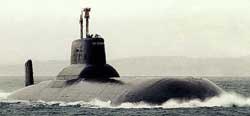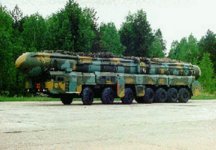The threat of
devastating nuclear attack by Russia against the United
States has not diminished, warns former Sec. of Defense
Robert McNamara.
Writing in Monday’s Los Angeles Times, McNamara and
co-author Helen Caldicott claim that the threat of a
nuclear catastrophe remains real, “whether by accident,
human fallibility or malfeasance.”
The Soviet Union collapsed on itself and the divide
between Eastern communism and Western democracy
disintegrated more than 13 years ago.
Because of that, the nightmare scenario is not on the
minds of many Americans today.
Missiles Still Pointed at New York, Cities
 Nevertheless,
the threat remains serious, McNamara and Caldicott
argue, because, despite the end of the Cold War in the
early 1990's, thousands of Russian nuclear warheads are
still pointed at the U.S. targeting many civilian
population centers.
Nevertheless,
the threat remains serious, McNamara and Caldicott
argue, because, despite the end of the Cold War in the
early 1990's, thousands of Russian nuclear warheads are
still pointed at the U.S. targeting many civilian
population centers.
McNamara, defense secretary to presidents Kennedy and
Johnson, U.S. and Caldicott, a pediatrician and head of
the Nuclear Policy Research Institute, say that Russian
nuclear targeting strategies haven't changed much — and
certainly not enough to reflect the thaw in relations
between both nations.
The pair also cite a January 2002 document from the
U.S. Foreign Military Studies Office at Fort
Leavenworth, Kan., titled, "Prototypes for Targeting
America, a Soviet Military Assessment."
 The
study reports that New York City is the single most
important target after military installations on the
U.S. Atlantic coast.
The
study reports that New York City is the single most
important target after military installations on the
U.S. Atlantic coast.
In addition, a report commissioned in the 1980s by
the U.S. Office of Technology Assessment is still as
relevant today.
It said Soviet nuclear war plans called for aiming
two one-megaton bombs at each of the following: The
three airports serving NYC; Wall Street; each major
bridge; all major rail centers; all power stations; four
NYC-area oil refineries; and the NYC port facilities.
Also, the Federal Emergency Management Agency, in a
recent report on nuclear-attack preparedness, featured a
map showing an obliterated New York City from nuclear
blasts and the resultant firestorms and fallout.
It predicted millions of people would instantly
perish, while most survivors would die shortly
thereafter from radiation burns and exposure.
Russia, Leading Nuclear Superpower

Russia, despite press reports to the contrary,
remains a nuclear superpower, arguably the greatest
nuclear superpower.
Between Moscow and Washington, the two governments
can lay claim to 96 percent of the world's 30,000
nuclear weapons.
In Russia, says the National Resources Defense
Council, most of the 8,200 nuclear warheads are pointing
at American cities and defense sites.
In return, most of the United States' 7,000 warheads
are targeting Russian missile silos and command centers.
Russia continues to lead the U.S. in smaller tactical
nuclear warheads. The U.S. destroyed most of its
tactical nuclear arsenal during the 1990s.
Of the 7,000 warheads in the U.S. arsenal, 2,500 are
maintained on a 24-hour ready alert status, and can be
launched within moments.
And, the commander of the Strategic Air Command has
only about three minutes to decide if a nuclear attack
warning is real or not. Then he has 10 minutes to find
the president and give him a 30-second attack briefing,
including options.
After that, the president has three minutes to decide
whether or not to retaliate and if so, which targets
will be hit. Once they were launched, U.S. missiles
would reach their Russian targets in about 15 to 30
minutes.
The situation is relatively similar in Russia, with
the exception that Moscow's early warning system is
rapidly aging.
According to the McNamara and Caldicott, the systems
of both countries sound alarms daily, in response to
wildfires, satellite launchings and solar reflections
off clouds or oceans.
But as the Russian system continues to decay, it may
be more difficult for Moscow to determine whether alerts
are real or not.
That's dangerous, argue experts, because it may mean
in the future, Russian commanders and leaders may have
to rely more on human judgment—a concept much less
reliable than computerized early warning systems that
operate without emotion.
Russia Continues Missile Build-up
Perhaps worse, as Russia's overall military structure
continues to suffer from a lack of funding and crumbles,
Moscow continues to pour scarce military funding into
more nuclear weapons.
 Russian
Defense Minister Sergei Ivanov told reporters Monday
Moscow will test its mobile version of the Topol-M
intercontinental ballistic missile once more before it
is put into service.
Russian
Defense Minister Sergei Ivanov told reporters Monday
Moscow will test its mobile version of the Topol-M
intercontinental ballistic missile once more before it
is put into service.
The missile, which will form the backbone of Russia's
nuclear defenses, is 47 tons, will carry one warhead,
and has an estimated range of 6,900 miles. Ground-based
Topol-M rockets are already in use; the mobile version
could be operational by 2006.
The last test of the mobile missile came earlier this
month, Ivanov said. It traveled its maximum distance
before hitting a target on the Kamchatka peninsula.
In addition, according to Agence France Presse, the
U.S. has hinted it may use a loophole to get out of a
treaty signed with Russia in 2002, which mandates both
countries slash their nuclear arsenals by two-thirds
over a decade.
Give Them Up
The liberal leaning McNamara and Caldicott say the
best strategy now is to simply abandon nuclear weapons
altogether.
They say Russia and the U.S. are now allied in the
global fight against terrorism.
As such, "their first duty in this effort should be
immediate and rapid bilateral nuclear disarmament,
accompanied by the other six nuclear nations (France,
Britain, China, India, Pakistan and Israel)," followed
by U.N. Security Council action "to ensure no other
nations, particularly Iran and North Korea, acquire
nuclear weapons."
"Time is not on our side," they wrote.